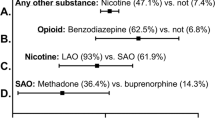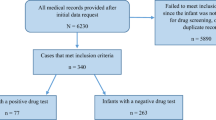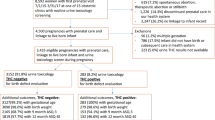Abstract
Objective:
We assessed umbilical cord tissue as a means of detecting fetal exposure to five classes of drugs of abuse.
Study Design:
In a multicentered study in Utah and New Jersey, we collected umbilical cord tissue when high-risk criteria were met for maternal illicit drug use. The deidentified umbilical cord specimens were analyzed for five drug classes: methamphetamine, opiates, cocaine, cannabinoids and phencyclidine. For each umbilical cord specimen, an enzyme-linked immunosorbent assay (ELISA)-based screening test was compared with a ‘gold standard’ test, consisting of gas or liquid chromatography tandem mass spectrometry.
Result:
A total of 498 umbilical cord samples were analyzed of which 157 (32%) were positive using mass spectrometric detection. The sensitivity and specificity of the ELISA-based test for each class of drugs tested were as follows: methamphetamine 97 and 97%, opiates 90 and 98%, cocaine 90 and 100%, cannabinoids 96 and 98% and phencyclidine (only 1 of the 498 umbilical cord sample was positive for phencyclidine) 100 and 100%.
Conclusion:
We judge that the performances of the ELISA-based tests are sufficient for clinical testing of fetal exposure to methamphetamine, opiates, cocaine and cannabinoids. Studies obtained on umbilical cord tissue can result in a more rapid return to the clinician than meconium testing, because waiting for meconium to be passed sometimes requires many days. Moreover, in some cases the meconium is passed in utero making collection impossible, whereas umbilical cord tissue should always be available for drug testing.
This is a preview of subscription content, access via your institution
Access options
Subscribe to this journal
Receive 12 print issues and online access
$259.00 per year
only $21.58 per issue
Buy this article
- Purchase on Springer Link
- Instant access to full article PDF
Prices may be subject to local taxes which are calculated during checkout
Similar content being viewed by others
References
Montgomery D, Plate C, Alder SC, Jones M, Jones J, Christensen RD . Testing for fetal exposure to illicit drugs using umbilical cord tissue vs meconium. J Perinatol 2006; 26: 11–14.
Le NL, Reiter A, Tomlinson K, Jones J, Moore C . The detection of oxycodone in meconium specimens. J Anal Toxicol 2005; 29: 54–57.
Zweig MH, Campbell G . Receiver-operating characteristic (ROC) plots: a fundamental evaluation tool in clinical medicine. Clin Chem 1993; 39: 561–577.
Addis A, Moretti ME, Ahmed SF, Einarson TR, Koren G . Fetal effects of cocaine: an updated meta-analysis. Reprod Toxicol 2001; 15: 341–369.
Church MW, Morback CA, Subramanian MG . Comparative effects of prenatal cocaine, alcohol, and undernutrition on maternal/fetal toxicity and fetal body composition in the Sprague–Dawley rat with observations on strain-dependent differences. Neurotoxicol Teratol 1995; 17: 559–567.
Fried RA, Watkinson B . 36- and 48-month neurobehavioral follow-up of children prenatally exposed to marijuana, cigarettes, and alcohol. J Dev Behav Pediatr 1990; 11: 49–58.
Goldschmidt L, Day NL, Richardson GA . Effects of prenatal marijuana exposure on child behavior problems at age 10. Neurotoxicol Teratol 2000; 22: 325–336.
Oro AS, Dixon SD . Perinatal cocaine and methamphetamine exposure: maternal and neonatal correlates. J Pediatr 1987; 111: 571–578.
Plessinger MA . Prenatal exposure to amphetamines. Risks and adverse outcomes in pregnancy. Obstet Gynecol Clin North Am 1998; 25: 119–138.
Dixon SD, Bejar R . Echoencephalographic findings in neonates associated with maternal cocaine and methamphetamine use: incidence and clinical correlates. J Pediatr 1989; 115: 770–778.
Gareri J, Klein J, Koren G . Drugs of abuse testing in meconium. Clinica Chimica Acta 2006; 366: 101–111.
Ostrea Jr EM, Brady MJ, Parks PM, Asensio DC, Naluz A . Drug screening of meconium in infants of drug-dependent mothers: an alternative to urine testing. J Pediatr 1989; 115: 474–477.
Ostrea Jr EM, Romero A, Yee H . Adaptation of the meconium drug test for mass screening. J Pediatr 1993; 122: 152–154.
Moore C, Negrusz A, Lewis D . Determination of drugs of abuse in meconium. J Chromatogr B Biomed Sci Appl 1998; 713: 137–146.
Ostrea Jr EM, Brady M, Gause S, Raymundo AL, Stevens M . Drug screening of newborns by meconium analysis: a large-scale, prospective, epidemiologic study. Pediatrics 1992; 89: 107–113.
Moriya F, Chan KM, Noguchi TT, Wu PY . Testing for drugs of abuse in meconium of newborn infants. J Anal Toxicol 1994; 18: 41–45.
Ostrea Jr EM, Knapp DK, Tannenbaum L, Ostrea AR, Romero A, Salari V et al. Estimates of illicit drug use during pregnancy by maternal interview, hair analysis, and meconium analysis. J Pediatr 2001; 138: 344–348.
Bar-Oz B, Klein J, Karaskov T, Koren G . Comparison of meconium and neonatal hair analysis for detection of gestational exposure to drugs of abuse. Arch Dis Child Fetal Neonatal Ed 2003; 88: F98–F100.
Vinner E, Vignau J, Thibault D, Codaccioni X, Brassart C, Humbert L et al. Neonatal hair analysis contribution to establishing a gestational drug exposure profile and predicting a withdrawal syndrome. Ther Drug Monit 2003; 25: 421–432.
Garcia-Bournissen F, Rokach B, Karaskov T, Koren G . Cocaine detection in maternal and neonatal hair: implications to fetal toxicology. Ther Drug Monit 2007; 29: 71–76.
Ostrea Jr EM, Romero A, Knapp DK, Ostrea AR, Lucena JE, Utarnachitt RB . Postmortem drug analysis of meconium in early-gestation human fetuses exposed to cocaine: clinical implications. J Pediatr 1994; 124: 477–479.
Silvestre MA, Lucena JE, Roxas Jr R, Evangelista ES, Ostrea Jr EM . Effects of timing, dosage, and duration of morphine pregnancy on the amount of morphine in meconium in a rat model. Biol Neonate 1997; 72: 112–117.
Acknowledgements
We thank the nurses of the Labor and Delivery Units and the Neonatal Intensive Care Units at Logan Regional, McKay-Dee, LDS and University Hospital, UMDNJ, for their valuable assistance in collecting the umbilical cord specimens for this study. This work was supported by grant 2 R44 DA017412-02A1 from the National Institute of Drug Abuse.
Author information
Authors and Affiliations
Corresponding author
Rights and permissions
About this article
Cite this article
Montgomery, D., Plate, C., Jones, M. et al. Using umbilical cord tissue to detect fetal exposure to illicit drugs: a multicentered study in Utah and New Jersey. J Perinatol 28, 750–753 (2008). https://doi.org/10.1038/jp.2008.97
Received:
Revised:
Accepted:
Published:
Issue Date:
DOI: https://doi.org/10.1038/jp.2008.97
Keywords
This article is cited by
-
Neonatal abstinence syndrome: Effectiveness of targeted umbilical cord drug screening
Journal of Perinatology (2022)
-
Agreement of umbilical cord drug and cotinine levels with maternal self-report of drug use and smoking during pregnancy
Journal of Perinatology (2011)



